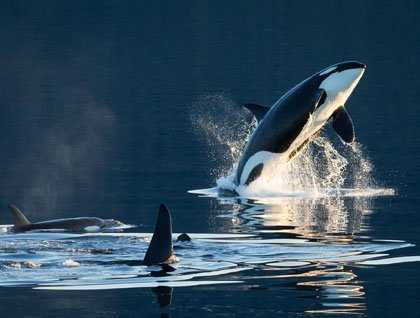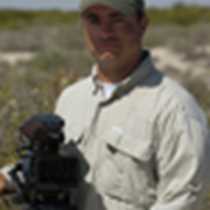Our nighttime departure from Juneau took us southward to begin our week's exploration of Southeast Alaska. By morning, we were plying the waters of Stephens Passage, searching for marine life or possible sightings of bears along the shores of Admiralty Island. We looped southward in Stephens Passage, then back northward along its mainland shores where we found our first humpback whale. Getting our first taste of the rich marine life of the region, we then passed several groups of Dall's porpoises zipping across the surface to breathe. Fingers of clouds wrapped down around the forested hills. In the distance we could see flocks of Pacific loons flying northward. As we reached the entrance to Endicott Arm, we encountered another lone humpback whale surfacing serenely and occasionally lifting its flukes in the air. Throngs of marbled murrelets dotted the calm waters, and a gang of Steller sea lions swam by as we approached the shallow bar at the entrance to the fjord, deposited as a terminal moraine by the glacier that once filled this valley.
Endicott Arm is a long and very scenic fjord, bordered by forested hills along its lower reaches, eventually turning steeper and more barren the deeper it winds into the mountains of the Coastal Range. The fjord's mirror-calm waters formed elegant reflections of the many icebergs drifting slowly seaward. Toward the far end of the fjord, the rafting icebergs thickened as we reached dramatic views of Dawes Glacier spilling out of the mountains, and ending in an enormous white and blue glacial face where it meets the fjord waters. Here we lowered our fleet of inflatable boats to further explore the sculpted icebergs, the many waterfalls cascading down from the snow-capped mountains, and eventually enjoying closer views of the monstrous glacier that carved this stunning valley. We gave a cautiously wide berth to the numerous harbor seals that had hauled out onto the icebergs, some of which were now accompanied by single, new, day's-old pups. We waited patiently near the glacier's face, hoping to see it calve large chunks of ice into the sea. The sky had mostly cleared, giving us spectacular views of the surrounding mountain scenery.
We eventually returned to the warmth of our ship, and turned to make our way back along the winding course of the fjord. We paused again near the mouth of the fjord, this time awaiting a float plane from Juneau that delivered our final two guests who were arriving a bit late to the ship, but in grand style. The sun continued to glance off of the snow-draped peaks, casting magical reflections across the waters as we left the fjord, returning into Stephens Passage. After dinner, Dall's porpoises came to ride along on the ship's bow wave. Shortly after they departed, the call came out that a group of killer whales had been sighted ahead of the ship. We drew closer and slowed to watch them. It was a large group of resident-type whales named AG-Pod by researchers, which have been known from the waters of Southeast Alaska and also Prince William Sound for several decades. As the sun was dipping low over Admiralty Island, the killer whales cavorted as if with glee; lob-tailing, spy-hopping, and breaching many times to cheers from all of us gathered on the ship's decks. As the whales continued surfacing peacefully around us, alpenglow tinted the snowy peaks of the Coast Range as the setting sun painted colorful skies to end our day.









